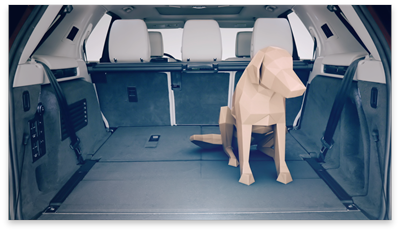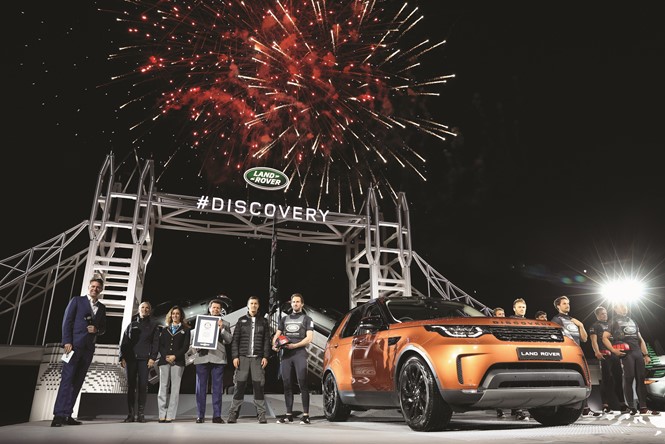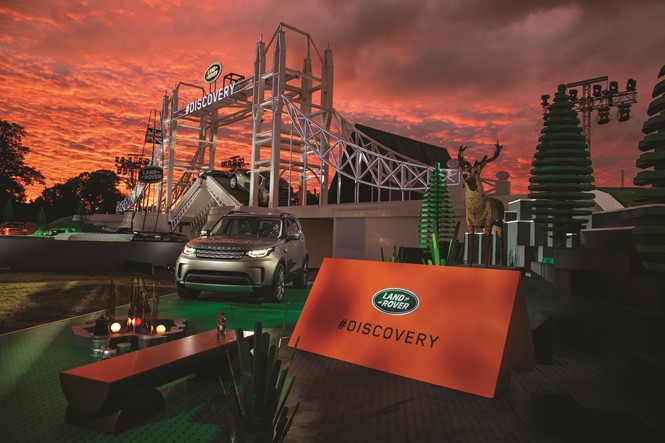Road show
Over the decades, Land Rover’s brand positioning and design ethos has evolved, but it retains a direct tie to its heritage and its origins. How does the new Discovery fit within that landscape? Brittany Golob reports from the launch
Deer frolicked across the rolling lawn at Packington Hall as a brass band welcomed attendees to the 28 September 2016 launch of the new Land Rover Discovery. In the background, was a pile of 5,805,846 Legos in the shape of London’s Tower Bridge, a picnic area, a woodland campsite, and even a deer, butterfly, squirrel and rabbit.
“If you think of pictures of Land Rover, it’s this sort of vista where they’re photographed,” UK MD of Jaguar Land Rover Jeremy Hicks says as he sweeps a hand across the landscape.
For a company with a history of adventure, of discovery, of design and of breaking boundaries, the launch was as true a brand expression as could have been created. The company traces its design origins to a beach on the island of Anglesey in Wales where the brothers Wilks drew a picture in the sand of a car that could tow and run off road with equal ease. The 1947 sketch sparked a half century of design thinking centred around utility and elegance.
When the Discovery was being developed in the late 1980s, Land Rover approached London-based brand consultancy Conran Design Group to design the interiors of the car. ‘Design for Transport,’ a book edited by Mike Tovey, says the initial brief called for Conran to ignore the way cars are traditionally designed and consider the Discovery as a lifestyle accessory. The Discovery was born, a blend of luxury and adventure, and swiftly received a British Design Award in 1989 before setting the standard for the future of interior design in the automotive industry, according to Tovey.
Since then, there has been a distinct lack of revolution in Discovery design, and that’s the way Land Rover likes it. “You can see where the brand has come from and you can see where it’s going. We’re not a revolutionary company in that regard,” Hicks says. He points to the stepped roof, a consistent design touchpoint that runs across the Discovery series and is carried forward in the new Discovery 5. That kind of evolution is intentional. “We are proud of our heritage, of inventing the first car that could go anywhere, and we continue to cherish that authenticity,” Jaguar Land Rover CEO Ralf Speth says. “Our tradition is to build cars that redefine driving and the new Discovery is true to that commitment.”
The Discovery comes from a long brand heritage but has its own unique quirks of design including a strong connectivity to digital communications, an emphasis on British creativity, extreme versatility and a family focus. Many of those elements carry through the Land Rover story from 1947 forward.
The Land Rover Defender is the standard-bearer in adventure automotives. There is scarcely a terrain it hasn’t conquered. It has been put to use for charities working in remote jungles and savannahs, explorers discovering new places and travellers round the world. Discovery draws its versatility from that heritage.
On the other end of the spectrum, the Range Rover is useful luxury. “The Range Rover is a car that is as at home driving across the fields on a shoot, with mud all the way up the side, as it is turning up outside an opera,” Hicks says. It lends its sense of family focus and understated luxury to the Discovery. The Discovery itself leads the way in digital connectivity though, setting a new goal for the rest of the company’s vehicles to reach. Gerry McGovern, Land Rover’s chief design officer says the digital aspects are a departure in auto design, just as its initial interior design was back in 1989.

“We are proud of our heritage, of
inventing the first car that could
go anywhere, and we continue to cherish that authenticity.”
“As it has evolved, it has become known as the vehicle that can take you anywhere and that was the challenge when designing the new one because it needed to retain those things while still moving the vehicle on,” says McGovern. “We recognised the past while still moving forward.”
Bringing that vision to life required the company to put its engineering to the test. Over the course of 28 months, the Discovery covered over 1m miles in 20 countries and experienced temperatures from the arctic -35 degree chill in Sweden to over 50 degrees in the scorching desert of the Arabian peninsula. Thus the Lego bunnies and deer of its launch were not out of place.
“From a design point of view, evolution is very much the order of the day,” says Hicks. “Inside the car, that’s where we can push boundaries in terms of technology.” Everything inside the car is considered as deeply as it was in 1989 when Conran first looked into the aluminium shell that would become the Discovery. From the sounds the car makes – Hicks even mimics the closing doors’ ‘dumpf!’ noise – to the way the seats look and feel and how the digital interface functions is about making a car that is at once useful and elegant.
Thus, the serene setting at the manor house outside Coventry, UK was disrupted by a booming soundtrack that ushered in a helicopter swooping overhead. Then, Bear Grylls appeared rappelling down to the transom of the Lego Tower Bridge and slapping the final Lego piece in place which proudly proclaimed the Guinness World Record.
In true trendsetter fashion, Land Rover worked with Guinness World Records to create the largest Lego sculpture in the world. The company chose to work with Lego to emphasise that Discovery is a family vehicle, says Hicks. The sculpture itself broke a 2013 record set by a model of a Star Wars X-Wing fighter that was comprised of 5,3335,200 bricks and situated in New York’s Times Square. Lucia Sinigagliesi, the official adjudicator for Guinness World Records present at the launch says, “When I gave the certificate to the CEO of Jaguar Land Rover he looked extremely happy. It’s such a positive message and we as a brand care very much about how we do things, about our integrity and about the respect we have for our record holders.”
Guinness World Records consistently works with brands to set new records, often at events such as the Discovery launch. The association allows the brand to align itself with innovation and push the boundaries of what can be achieved.
For Land Rover, those values align with its own outlook on engineering and design. The event itself took place just eight miles from Land Rover’s Solihull home base. The factory has been in operation since 1948 and is a leader in British engineering. The Igenium-branded engine allows the Discovery a maximum torque of 1,500rpm. That also meant the Discovery could blaze out from atop the Lego sculpture at the launch, through a river, while towing a Lego sailboat and carrying seven members of the Land Rover-sponsored Ben Ainslie Racing team.
Both Ainslie and Grylls pointed to the pioneering spirit of Land Rover, its usefulness as a family vehicle and the ability to adventure when talking about the new Discovery. A winding road – like any road worthy of a Land Rover – can be drawn from that beach in Anglesey to the manor in Coventry; from where the Defender was drawn in the sand to where a sailboat was drawn behind the new Discovery. The dream was made real. “We’ve always stood for that,” Hicks says. “It’s a continuation of the lineage. It doesn’t change anything for us either, it’s just a continuation of what makes Land Rover authentic. When we do things it’s for real.”














